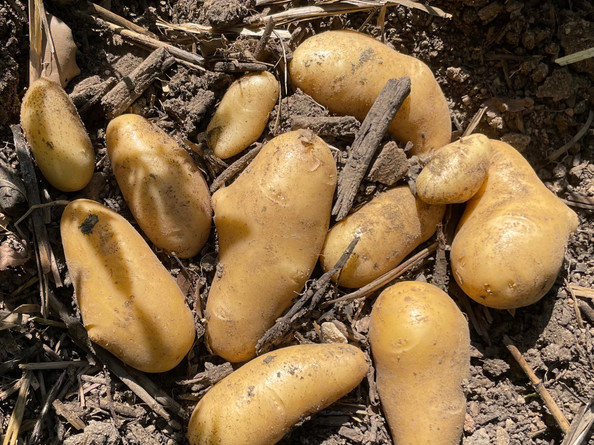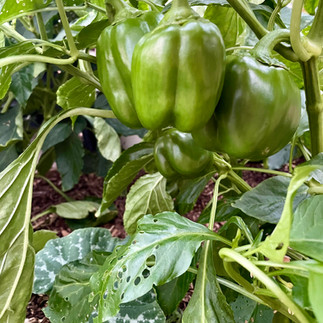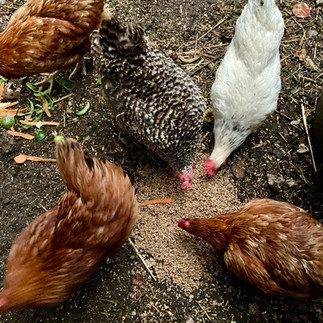Harvest Home
- JanetJoanouWeiner

- Dec 18, 2023
- 6 min read
The first week of December here in the Cévennes, we harvest olives. Our crop this year was by far our most abundant, taking us two days to pick, and three trips to the olive mill. One of our colleagues has been clearing the land and pruning around some old, old, old olive trees and they're now producing fruit. We are thrilled.

Aren't those colors magnificent?
The easiest way to get the olives off the tree is by shaking the branches as seen here. I'm usually on the "pick them off the ground afterwards" team.
Blue skies or rainy gray, we love harvesting the olives. Even with the occasional "oops" I spilled my full bucket!
For the first time, we yielded over 100 kilos of olives, meaning the resulting 14 liters of olive oil is 100% ours. I literally whooped at the olive mill, causing amusement among the workers who do this sort of thing daily.
Here's a brief glimpse of the process from crate to bottle. We take our olives to a local winery/olive mill, where two men-of-the-earth weigh and process them. A few days later, we pick up our containers of oil. This year's batch is greener in looks and taste, a little pungent. I like it. Over time, the sediment settles and it will become slightly less opaque.
Our co-worker grew wheat on the land and will grind and then bake it into his delicious sourdough bread––even our French friends say it's the best they've ever eaten! That's high praise, ideed. We'll make an event of tasting the oil with this special bread, enjoying the fruits of the land God has given us.
I'm reading a writer acquaintance's book, The Accidental Homesteader by Kathi Lipp, and relating to the premise and many of the anecdotes. As the title implies, sometimes we back into "homesteading" or inch our way towards such a lifestyle. My husband and I ended up with a quantity of land here in the south of France and in the past few years we've invested resources in developing and utilizing all is has to offer.
Of course, we're still learning. Lots. But we're farther down the road than we once were and the joy and satisfaction has been immense. We've had successes and failures. Or should I say "learning opportunities"?
One of our biggest learning curves pertains to growing food. There's a lot to understand about timing, soil, watering, and so on. Each year, we gain knowledge while experiencing extreme variables in the weather––year to year, and season to season. Our region runs blazing hot in the summer down to low winter temperatures that can hover around the freezing zone.
The biggest challenge is the heat, which doesn't always arrive in the same month. This past summer it went on and on and on at record highs. Whew. Despite that, some things did well. And, we have the luxury of a grocery store down the road as we grow (haha!) in our abilities. Still, it's so satisfying to watch something develop from a tiny seed to food on your table. We'd love to grow enough to cover a lot of our community's needs, with plenty left over to share. That's the dream!
Learning Opportunity: After complete failure in growing potatoes in the past, these finally made it to maturity. I happily dug them up in June, and let them cure on the dirt for a while. Warned against the direct sun, I put them in the basket and moved them to our cool cellar. Too soon. Within days, we smelled something funny down there. To my great dismay, the majority had rotted. I had to throw them alllll away. Big, BIG sigh.
Now for a few successes. A generous local friend gave me about 300 seedlings from her brother's onion farm. Cévennes onions are "AOP" or Appellation d'Origine Protégée, meaning only this variety, and grown in this region, may call itself a Cévennes onion, in the same way that only white sparkling wine from the Champagne region may use that name.
Top left: planting the seedlings
Top middle: (Not an onion photo, but it worked in the layout)
Garlic! Just stuck cloves in the ground at the end of fall and voilà! Yummy garlic ready to eat in late spring, early summer.
Bottom: Onion harvest, plus a few companion plant beets.
The hours of planting the seedlings paid off. I harvested lots of onions, albeit small ones. True to their name and reputation, they were crunchy, seet, and juicy. Next year, I hope to figure out how to grow both the onions and garlic larger as the small ones are a pain to peel.
Tomatoes thrive in the hot sun, and we have that in abundance. They require a fair amount of water and, fortunately, I'm able to use rainwater from our catchment tanks. In early fall, we installed a drip system so my gardening life will be even easier next year.
Cucumbers were a new crop for me this year. They seem to mature overnight and as is true for all garden vegetables, they're nothing like store bought. Their juicy coolness was a welcome antidote to summer heat. Splash on a little vinegar and garlic sea salt...delicious!
While these lovely lavender striped eggplants look promising, they were few in number for the amount of plants I grew. They made a yummy caviar d'aubergine, a puree of eggplant, garlic, salt, and olive oil.
Green bell peppers were a surprise success story. They grew prolifically from seeds saved from a grocery store pepper bought last year. Normally, I don't like green peppers, but these had a fresh, light taste. Much less bitter than store-bought.
Another new addition for me this year was cayenne peppers. So fun to watch them grow and change color. Just last night we had some spicy salsa with these guys adding heat.
Arugula grows well here late fall and through winter. You can practically taste the vitamins in all their peppery goodness.
Not pictured are the failed green beans. They shriveled in the heat, no matter how much water and shade I gave them, unlike last year when they thrived in similar conditions.
Flowers have been challenging to grow in our rocky, limey soil. And did I mention the heat? Yet my marigolds, grown from seeds like all the plants, went wild this year. Right next to the sad, brown green beans. I can't figure it out, but enjoyed these brilliant orange beauties until recently.

And then there was (is!) the Calendula. These perky, hardy gals just keep going through heat, through frost, through it all. An ointment made from their buds steeped in olive oil for a month, then strained, fights skin rashes, cuts, burns, and more. A friend used some after several weeks of prescription ointment failed and her skim problem cleared up within a week. Well done, Calendula!

These lovely ladies also added color to our fall decorations in small bud vases around the house. I love how their colors and centers change.
Another surprising use for Calendula is to feed them to the chickens for more golden yolks. It worked!

Speaking of chickens . . . well I could go on a long time about the chickens. Don't worry, I won't. Suffice to say, they are a source of delight, but not without some disappointment. We've lost three to unknown causes (sickness? why didn't the others get it?) And after a recent egg drought, we changed feed and they are back in business in quantity and quality. We're all happy about that.
Out-dated and moth-filled quinoa was a hit. And every once in a while one of them produces a super egg, with a huge or double yolk.
Their personalities crack me up. Red-girl is very curious as I clean out the coop. Others are independent, introverted. The white one thinks she's a rooster, which is apparently normal when there isn't one. Gray-girl recently molted and lost so many feathers and looked so scrawny it scared me despite being assured its normal. During that time, the others picked on her, literally. She's (secretly) my favorite, so I snuck her special treats.
Have you ever thought about how many expressions come from chickens? Hen–pecked, cooped up, pecking order to name a few. "You don't need to crow about it" certainly came from someone around a noisy, cocky (!) rooster. We hope to borrow or rent one (?) in the future to have chicks. Not sure if that will work out, we'll see.
I'm extremely grateful for the opportunity to enjoy the land and its fruits. I think we're designed to be connected to this process of tending, nurturing the land and its fruits, as well as our food. The deep satisfaction that comes with overseeing the process, particularly when the results are good, is worth all the challenges and the work.
La vie est belle!
































































I can so relate to your gardening experiences! This was so fun reading about how things grow - some similarities and other differences in what you can grow there. May God continue to grow and bless your harvest - from the land and also in the hearts of your friends. ❤️